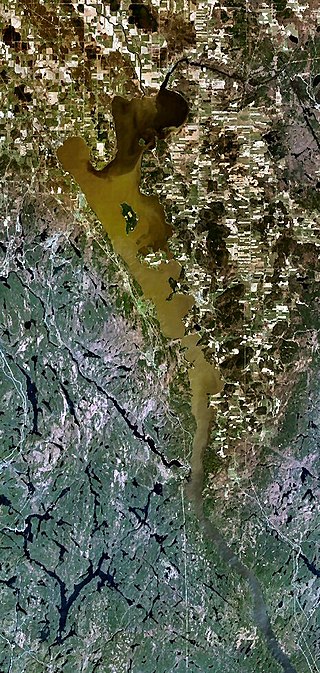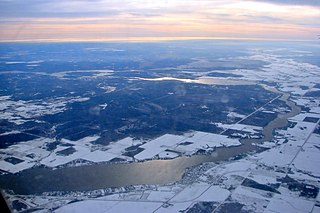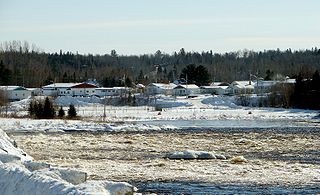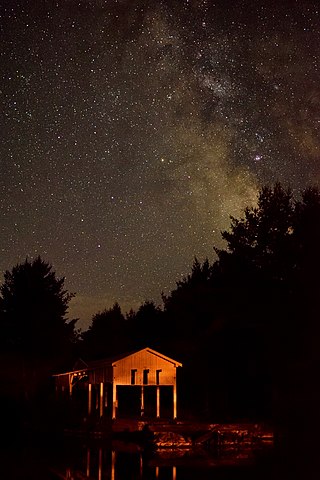
The Loch Ness Monster, affectionately known as Nessie, is a creature in Scottish folklore that is said to inhabit Loch Ness in the Scottish Highlands. It is often described as large, long-necked, and with one or more humps protruding from the water. Popular interest and belief in the creature has varied since it was brought to worldwide attention in 1933. Evidence of its existence is anecdotal with a number of disputed photographs and sonar readings.

In Canadian folklore, the Ogopogo is a lake monster said to inhabit Okanagan Lake in British Columbia, Canada. Some scholars have charted the entity's development from First Nations folklore and widespread water monster folklore motifs. The Ogopogo now plays a role in the commercial symbolism and media representation of the region.

Temiskaming Shores is a city in the Timiskaming District in Northeastern Ontario, Canada. It was created by the amalgamation of the town of New Liskeard, the town of Haileybury, and the township of Dymond in 2004. The city had a total population of 9,634 in the Canada 2021 Census. Temiskaming Shores is Ontario's second-smallest city, in terms of population, after Dryden. Haileybury is the seat of Timiskaming District.

Lake Timiskaming or Lake Temiskaming is a large freshwater lake on the provincial boundary between Ontario and Quebec, Canada. The lake, which forms part of the Ottawa River, is 110 kilometres (68 mi) in length and covers an area of almost 295 km2 (114 sq mi). Its water level ranges between 175 m (574 ft) and 179 m (587 ft) above sea-level, with a mean annual average of 178.4 m (585 ft). The lake is in places up to 216 m (709 ft) deep. There are several islands on the lake, notably Mann and du Collège Islands.

The Winnipeg River is a Canadian river that flows roughly northwest from Lake of the Woods in the province of Ontario to Lake Winnipeg in Manitoba. This river is 235 kilometres (146 mi) long from the Norman Dam in Kenora to its mouth at Lake Winnipeg. Its watershed is 106,500 square kilometres (41,100 sq mi) in area, mainly in Canada. About 29,000 square kilometres (11,000 sq mi) of the watershed is in northern Minnesota, United States.
The Clay Belt is a vast tract of fertile soil stretching between the Cochrane District in Ontario, and Abitibi County in Quebec, covering 180,000 square kilometres (69,000 sq mi) in total with 120,000 square kilometres (46,000 sq mi) of that in Ontario. It is generally subdivided into the Great Clay Belt to the north running eastward from Kapuskasing, past Lake Abitibi and on to Amos, and the V-shaped Lesser Clay Belt to its south, running from Englehart down to the Wabi River to the northern tip of Lake Timiskaming, and long the eastern side of Timiskaming and back up to Rouyn-Noranda. The Clay Belt is the result of the draining of the Glacial Lake Ojibway around 8,200 BP, whose lakebed sediment forms the modern landform. The Clay Belt is surrounded by the Canadian Shield, forming an island of "southern flatlands" in the midst of the hilly and rocky surroundings. Similar "glaciolacustrine deposits" dot the northern areas of Ontario, Quebec and Labrador.

Témiscaming is a city located at the south end of Lac Témiscamingue on the upper Ottawa River in the Témiscamingue Regional County Municipality of western Quebec, Canada. Also nearby is Lake Kipawa.
In northeastern Ohio and Michigan folklore, Bessie is a name given to a lake monster in Lake Erie, also known as South Bay Bessie or simply The Lake Erie Monster. The first recorded sighting of Bessie occurred in 1817, and more sightings have occurred intermittently and in greater frequency in the last three decades. Bessie is reported to be snake-like and 30 to 40 ft long, at least a foot in diameter, with a grayish color.
Lac Simard is a freshwater lake in the municipality of Laforce, in the Regional County Municipality (RCM) of Temiscamingue, in northwestern Quebec, Canada.

Devil's Rock is a granite escarpment located 5 kilometres (3 mi) south of Temiskaming Shores, Ontario, Canada. The cliffs rise 300 feet (91 m) above Lake Timiskaming and extend nearly as far underwater as they do above, giving Devil's Rock a cliff face roughly 600 feet (180 m) tall.
Timiskaming is a word from the Algonquin Temikami or Temikaming, from tim 'deep' and kami 'open waters'. Alternate spellings include Temiskaming, Témiscaming and Témiscamingue. The word Temagami comes from the same root.

Notre-Dame-du-Nord is a municipality in the Canadian province of Quebec, located in the Témiscamingue Regional County Municipality. It is located at the northern end of Lake Timiskaming where the Ottawa River enters into this lake.

The Sturgeon River Provincial Park is a provincial park in northern Ontario, Canada, that protects about 70 kilometres (43 mi) long section of the Sturgeon River and its banks, from Woods Lake to the Sudbury-Nipissing District boundary. It was established in 1989 and expanded in 2005. It protects outstanding water routes that provide recreational canoe camping opportunities. Other activities include hunting and fishing.
The ZEC Restigo is a "zone d'exploitation contrôlée" (ZEC) located the unorganized territory Les Lacs-du-Témiscamingue, in the Témiscamingue Regional County Municipality, in the administrative region of Abitibi-Témiscamingue, Quebec, Canada.

The Lac des Quinze is a freshwater body extending into the municipalities of Moffet, Laverlochère-Angliers, Latulipe-et-Gaboury, Quebec, Guérin, and Rémigny in the Témiscamingue (RCM), in the Abitibi-Témiscamingue administrative region, in Quebec, in Canada.
Raven Lake is a freshwater body of Canada that straddles the boundary between:
The zec Dumoine is a controlled harvesting zone located in the unorganized territory of Les Lacs-du-Témiscamingue, in the MRC Témiscamingue Regional County Municipality, in the administrative region of Abitibi-Témiscamingue, in Quebec, in Canada.

The parc national d'Opémican is a national park of Quebec (Canada) located south of Abitibi-Témiscamingue, between Laniel and Témiscaming. The park is 252 kilometres (156.59 mi) in size and was established on 19 December 2013. It ensures the protection of the characteristic landscape of the Southern Laurentians.

Mount Cheminis is an inselberg/monadnock located in Quebec, Canada, near the Ontario border.














